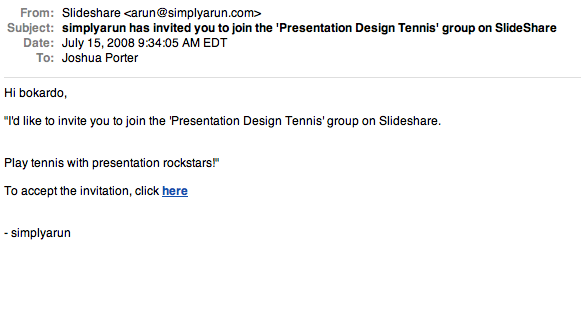Interface Design Principle: Let people learn more
Update #2: Jon from Slideshare responds in the comments with excellent help. And in reflecting on this post…I realized it’s silly to call the design (or Slideshare) evil. This isn’t evil…it’s an interface. Update #1: There is indeed a group on Slideshare called Presentation Design Tennis. So the following email is true… I received an […]
Update #2: Jon from Slideshare responds in the comments with excellent help. And in reflecting on this post…I realized it’s silly to call the design (or Slideshare) evil. This isn’t evil…it’s an interface.
Update #1: There is indeed a group on Slideshare called Presentation Design Tennis. So the following email is true…
I received an email that was supposedly from Slideshare. I don’t know if it really is from Slideshare, but it feels like a devious email either way.
Here is a screenshot:
As you can see, there is a single link in the email. It is a confirmation link, meaning that if you click on it then you are confirming your acceptance of the invitation.
The problem is, I don’t know if I want to accept the invitation yet. There is no way for me to find out more about “Presentation Design Tennis”, which sounds interesting but bears no credibility at all since I’ve never heard of it. What I really want is the ability to find out more about it. If there had been a “find out more” link, I would have clicked it.
In this case, though, the design is somewhat evil careless, in that it tempts you by telling you of an invitation (social influence) but doesn’t allow you to find out anything before you accept. (Classmates.com is currently killing the respect of their users in this same way.)
This also reminds me of the subtleness of Facebook’s Beacon platform, which was designed in a similar manner…where the default action would get you involved in something that maybe you didn’t want to be involved in.
The takeaway is that this is really about respecting users. The best experience for users in this case would be to be able to find out more at their leisure, without committing to anything they don’t want to. A good solution might be “Accept Invitation” or “Learn more” links. The “Sign Up or Learn More” patterns seems to be in wide use these days, and for good reason. Yes, you might have lower numbers of people actually doing the thing (in this case joining the group), but you’ll know that the people who did end up joining really want to be there.
